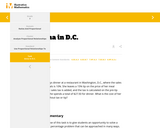
For this task, students use various approaches to solve a multi-step percentage problem.
- Subject:
- Mathematics
- Material Type:
- Activity/Lab
- Provider:
- Illustrative Mathematics
- Author:
- Illustrative Mathematics
- Date Added:
- 02/26/2019

For this task, students use various approaches to solve a multi-step percentage problem.
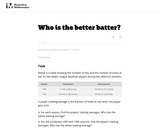
This is a task from the Illustrative Mathematics website that is one part of a complete illustration of the standard to which it is aligned. Each task has at least one solution and some commentary that addresses important asects of the task and its potential use. Here are the first few lines of the commentary for this task: Below is a table showing the number of hits and the number of times at bat for two Major League Baseball players during two different seasons: SeasonDe...
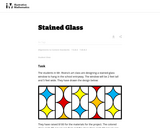
This is a task from the Illustrative Mathematics website that is one part of a complete illustration of the standard to which it is aligned. Each task has at least one solution and some commentary that addresses important asects of the task and its potential use. Here are the first few lines of the commentary for this task: The students in Mr. Rivera's art class are designing a stained-glass window to hang in the school entryway. The window will be 2 feet tall and 5 feet w...
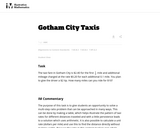
This is a task from the Illustrative Mathematics website that is one part of a complete illustration of the standard to which it is aligned. Each task has at least one solution and some commentary that addresses important asects of the task and its potential use. Here are the first few lines of the commentary for this task: The taxi fare in Gotham City is \$2.40 for the first $\frac{1}{2}$ mile and additional mileage charged at the rate \$0.20 for each additional 0.1 mile....

This 7th grade Math parent guide explains the content in straightforward terms so they can support their children’s learning at home and will encourage caretaker engagement with lessons.

Our Teacher Guides are meant to support the use of our online course and unit content. Please use these to accompany the use of our content and for ideas to support struggling learners, those needing extension and for additional resources.
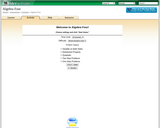
In this activity, students practice solving algebraic equations.
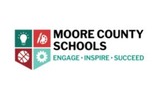
This is a hands-on project that uses George Orwell's novel, Animal Farm, as the touchstone text. Students work in groups to construct a functioning windmill that can generate electricity. Each student has a role based on the characters in the book. There are also segments of the project that focus on extracting key information from the text.
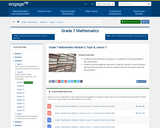
In this lesson, students understand that an equation is a statement of equality between two expressions. Students build an algebraic expression using the context of a word problem and use that expression to write an equation that can be used to solve the word problem.

CK-12 Middle School Math Concepts for seventh grade provides a complete textbook. It presents topics including algebraic thinking, patterns, decimals, decimal operations, fractions, fraction operations, integers, integer operations, ratios, rates, proportions, percents, percent applications, equations, solving equations, inequalities, functions, graphing functions, geometry, plane geometry, solid geometry, area, perimeter, surface area, volume, statistics including mean, median, mode and range, graphing and types of graphs, and probability.

This document provides sample performance tasks/assessment items for Common Core State Standards Grade 7 Math provided by the Louisiana Department of Eduation. Both questions and exemplary responses are included.
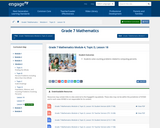
In this lesson, students solve counting problems related to computing percents.
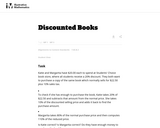
This purpose of this task is to help students see two different ways to look at percentages both as a decrease and an increase of an original amount. In addition, students have to turn a verbal description of several operations into mathematical symbols.
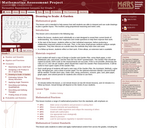
This lesson unit is intended to help assess how well students are able to interpret and use scale drawings to plan a garden layout. This involves using proportional reasoning and metric units.
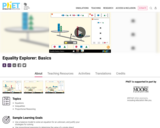
Sample Learning Goals
Use a balance model to solve an equation for an unknown, and justify your strategies for solving
Use proportional reasoning to determine the value of a single object
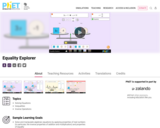
Sample Learning Goals
Solve and manipulate algebraic equations by applying properties of real numbers (in particular, the inverse properties of addition and multiplication) and properties of equality
Solve and manipulate algebraic equations by substituting different values for a variable
Use a balance model to solve an equation for an unknown, and justify your strategies for solving
Solve an equation using only universal operations

For this activity, students convert between fractions, decimals and percents by playing a Percent Goodies game.

Students will use linear equations to solve unknown angle problems and other problems presented within context to understand that solving algebraic equations is all about the numbers. They use the number line to understand the properties of inequality and recognize when to preserve the inequality and when to reverse the inequality when solving problems leading to inequalities. They also interpret solutions within the context of problems. Additionally, students extend their study of geometric figures and the relationships between them as they apply their work with expressions and equations to solve problems
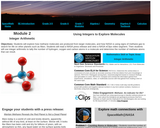
This is a set of three, one-page problems about the size and area of solar panels used to generate power. Learners will will use integer arithmetic to tally the number of hydrogen, oxygen and carbon atoms in a molecule and determine the number of methane atoms that can result. Options are presented so that students may learn about how NASA is using signs of methane gas to search for life on other planets, such as Mars, through a NASA press release or about how astrobiologists who are looking for life beyond Earth are using spectroscopy to identify methane plumes on Mars by viewing a NASA eClips video [7 min.]. This activity is part of the Space Math multi-media modules that integrate NASA press releases, NASA archival video, and mathematics problems targeted at specific math standards commonly encountered in middle school.
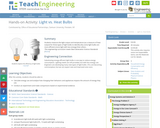
Students measure the light output and temperature (as a measure of heat output) for three types of light bulbs to identify why some light bulbs are more efficient (more light with less energy) than others.